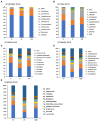Effects of glucose oxidase on growth performance, clinical symptoms, serum parameters, and intestinal health in piglets challenged by enterotoxigenic Escherichia coli
- PMID: 36267185
- PMCID: PMC9578003
- DOI: 10.3389/fmicb.2022.994151
Effects of glucose oxidase on growth performance, clinical symptoms, serum parameters, and intestinal health in piglets challenged by enterotoxigenic Escherichia coli
Abstract
Glucose oxidase (GOD) could benefit intestinal health and growth performance in animals. However, it is unknown whether GOD can protect piglets against bacterial challenge. This study aimed to evaluate the protective effects of GOD on growth performance, clinical symptoms, serum parameters, and intestinal health in piglets challenged by enterotoxigenic Escherichia coli (ETEC). A total of 44 male weaned piglets around 38 days old were divided into four groups (11 replicates/group): negative control (NC), positive control (PC), CS group (PC piglets +40 g/t colistin sulfate), and GOD group (PC piglets +200 g/t GOD). All piglets except those in NC were challenged with ETEC (E. coli K88) on the 11th day of the experiment. Parameter analysis was performed on the 21st day of the experiment. The results showed that the ETEC challenge elevated (p < 0.05) the rectal temperature and fecal score of piglets at certain time-points post-challenge, reduced (p < 0.05) serum glucose and IgG levels but increased (p < 0.05) serum alanine aminotransferase activity, as well as caused (p < 0.05) intestinal morphology impairment and inflammation. Supplemental GOD could replace CS to reverse (p < 0.05) the above changes and tended to increase (p = 0.099) average daily gain during the ETEC challenge. Besides, GOD addition reversed ETEC-induced losses (p < 0.05) in several beneficial bacteria (e.g., Lactobacillus salivarius) along with increases (p < 0.05) in certain harmful bacteria (e.g., Enterobacteriaceae and Escherichia/Shigella). Functional prediction of gut microbiota revealed that ETEC-induced upregulations (p < 0.05) of certain pathogenicity-related pathways (e.g., bacterial invasion of epithelial cells and shigellosis) were blocked by GOD addition, which also normalized the observed downregulations (p < 0.05) of bacterial pathways related to the metabolism of sugars, functional amino acids, nucleobases, and bile acids in challenged piglets. Collectively, GOD could be used as a potential antibiotic alternative to improve growth and serum parameters, as well as attenuate clinical symptoms and intestinal disruption in ETEC-challenged piglets, which could be associated with its ability to mitigate gut microbiota dysbiosis. Our findings provided evidence for the usage of GOD as an approach to restrict ETEC infection in pigs.
Keywords: antibiotic alternative; bacterial infection; body weight gain; gut microbiota; immune status; intestinal disruption; weaned piglet.
Copyright © 2022 Wang, Xie, Cao, Ye, Zhang, Dong, Feng and Zuo.
Conflict of interest statement
The authors declare that the research was conducted in the absence of any commercial or financial relationships that could be construed as a potential conflict of interest.
Figures



References
-
- Alauzet C., Aujoulat F., Lozniewski A., Ben-Brahim S., Domenjod C., Enault C., et al. . (2021). A new look at the genus solobacterium: a retrospective analysis of twenty-seven cases of infection involving S. moorei and a review of sequence databases and the literature. Microorganisms 9:1229. doi: 10.3390/microorganisms9061229, PMID: - DOI - PMC - PubMed
LinkOut - more resources
Full Text Sources
Miscellaneous

